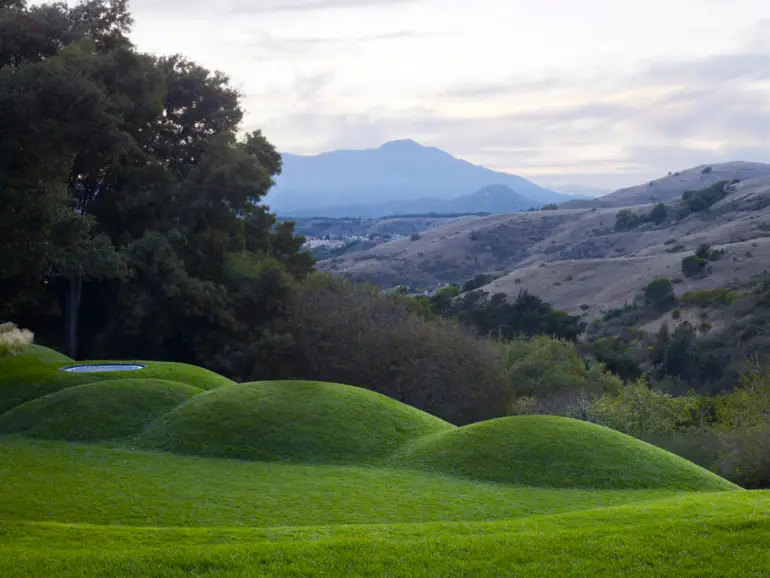Fun infuses this garden of pathways, ramps and mounds that doubles as land art and exhibition space for sculpture.
ABOUT EIGHT YEARS AGO, Tiburon art collectors Stuart and Gina Peterson approached landscape architects James Lord and Roderick Wyllie of the San Francisco firm Surfacedesign, Inc. for an unorthodox hilltop garden to mesh well with their modern, art-filled home.
“The journey through the garden was to be as important as the destinations within it,” Lord says.
Now, less than half an hour across the bay from San Francisco’s Crissy Field, where the Petersons helped fund an SFMOMA off-site exhibition of Mark di Suvero’s steel sculptures, the couple’s rectangular five-acre “park” at home is also one where walking, running, jumping, sliding and playing hide-and-seek amid wild grasses and art are all possible.
Although they wanted a garden that echoed the whimsy of their art collection, the Petersons also desired a place for their two boys and little daughter to play in. European play structures with slides and swings were one implemented solution, but in addition the designers offered more imaginative encounters with the land.
So, “on the south side of the garden, which was sheltered by the house, we created intimate, dense areas to lose oneself in,” Wyllie says.

They formed paths that are telescopic corridors to view art and that also link the entry garden on the west end to the rest of the undulating site that stretches eastward.
Just inside the pivoting entry gate, a straight path, conceived by artist and landscape architect Topher Delaney and left undisturbed, has stepping-stones that spell out a love poem by English poet Christopher Marlowe in Braille.
Midway up the path, a new ipe deck extends the wood floor of the dining room (when its large aluminum-and-glass garage door is rolled open) to the outdoors; it then ramps down, its increasingly faceted form resembling origami, and stops short of the paved path before hopping to the other side. This hyphenated deck is a formal threshold to the garden and also a climbing and sliding zone instantly favored by the children, two of whom were kindergartners when it was installed.

Beyond it, the path transitions into a newer walkway that is covered with long rectangular cement pavers laid in a staggered pattern; it wends past existing magnolia trees and a newly planted thicket of tall bamboo, interspersed with Japanese maples. This shaded rain garden, bordered by river rock and ferns, is fed by storm water that flows downhill and meanders past an amphitheater composed of a sculpted lawn and repurposed curbstones. It then turns into a beaten path that arcs around a wide grassy clearing graced by “Roundout,” a 2005 aluminum rabbit-like sculpture by Travis Constance that is ensconced within native grasses, including feathery yellow Nasella tenuissima.

“By choreographing a spatial sequence, you form an experience. When you go through a tall, narrow opening into a horizontal space, it is like swimming, and like slicing through water before spreading your arms,” Lord says.
As it happens, the open lawn slopes northward and covers four round mounds that took the place of an old swimming pool that had collapsed and was torn out. These artificial hills atop the repaired site mimic the open, rolling landscape in the distance, helping to frame views of the Marin hills and the San Francisco Bay.
“They look beautiful, but when you look closely, they are all about fun. They are play structures,” Lord says.
Built into one of the manmade hills is a ground trampoline for the children to jump on. Another, “Rabbit Hole Hill,” is riddled with holes large enough for golf balls to fall in, funnel through and emerge randomly in the garden. On a third mound Lord wanted a water bed–like balloon in the ground camouflaged by sod, but the idea was scratched as too difficult to maintain. Instead, a globular hobbit-size playhouse with a roof of marine-grade plywood slats is yet another hill, and it’s one the children can enter.
Although Surfacedesign’s work often involves large airport and institutional gardens across the globe, including in lush New Zealand and arid Saudi Arabia, “nearly half our work is residential. That’s because we are interested in dynamic spatial experiences, and such gardens can be asymmetrical and more expressionistic,” Wyllie says. “This one is a carefully considered mash-up of many influences.”

While the long views down each of the pathways reflect French perspectival techniques, a maze of hedges of lavenders and salvia that snakes back and forth to form enclosures for displaying sculptures, just west of the amphitheater, was inspired by English knot gardens. The designers also borrowed from serene Japanese gardens for areas that “look inward, toward the ground, and land art by artists Michal Heizer and James Turrell to make those playful forms out of the earth,” Wyllie says.
To the owners’ delight, these uncommon wonders captivate the children more than their slides and swings do. “According to Gina, the kids love to run and play in the garden and clamber on top of the earth forms and conjure up their own worlds,” Wyllie says. “They like to use their imaginations.”

